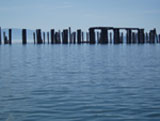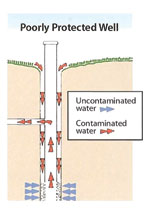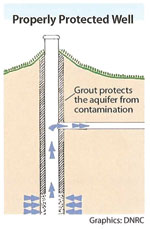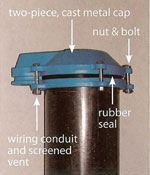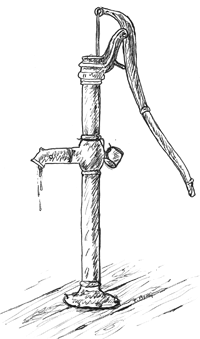 |
| Figure 4.5: Well pump. Source: Todd Berget |
Montana’s streams range from large year-round flowing rivers to small intermittent streams that flow only when recharged by precipitation or groundwater to ephemeral streams that flow only during large runoff events. Lakes range from large persistent natural freshwater systems to saline basins that evaporate completely each year. These surface waters contribute to uses including public water supplies, domestic household water, irrigation, livestock, industry, mining, and tourism. Our wellbeing, much of our economy, and a number of our recreational activities depend on the abundance and quality of water.
Cultural traditions, laws, and regulations work in concert to govern water distribution among Flathead Watershed water users. The guiding management principles stem from the Montana State Constitution which states “All persons are born free and have certain inalienable rights. They include the right to a clean and healthful environment and the rights of pursuing life’s basic necessities, enjoying and defending their lives and liberties, acquiring, possessing, and protecting property, and seeking their safety, health, and happiness in lawful ways. In enjoying these rights, all persons recognize corresponding responsibilities.”
Water pollution is a national, state-wide, and watershed-wide issue that threatens our opportunity to fully enjoy a clean and healthful environment. And as a headwaters state, we have a national responsibility to ensure citizens living downstream will also receive clean water from our state.
Drinking and Household Water
Well Construction and Maintenance | Resources |
Drinking water in the Flathead Watershed is supplied by municipalities through an intricate network of water engineering. Some residents still pull surface water from Flathead Lake. But, most of the residential and agricultural developments in the watershed rely on municipal and on-site groundwater wells that are fed by shallow aquifers. Glacial meltwater that permeated huge areas of gravel formed our aquifers ten thousand years ago. These shallow aquifers contain a complex network of organisms that naturally cleanse the waters. Numerous pollutants—such as nutrients (nitrogen and phosphorous), oil, gas, and heavy metals—can jeopardize the health of the aquifers. In addition, failing septic systems can contribute a variety of pollutants to groundwater, including coliform bacteria and a wide range of pharmaceutical and personal care products (PPCPs).
Wetlands, riparian areas, and floodplains that overlay these aquifers provide a buffer that filters out some or all of the nutrients and pollutants before they reach the water source. Well-defined shallow aquifers include 1) the Delta region between the north shore of Flathead Lake and the Flathead River, 2) the Evergreen aquifer between the Flathead and Whitefish Rivers, which is the most developed shallow aquifer, 3) the east side between the Flathead River and the foothills of the Swan Mountains, and 4) the Lost Creek fan west of the Stillwater River near the Salish Mountains. Most other shallow aquifers have developed along stream valleys.
Planning and Protecting Your Well
Wells capture groundwater from aquifers, making it available for our use. There are several consequential considerations regarding yield and placement of private wells. Drinking water from wells is a valuable resource that requires proper planning and protection. Like surface water, ground water can become contaminated by naturally occurring elements, compounds, and metals; household, agricultural, and industrial chemicals; pharmaceuticals; bacteria and viruses from septic systems and animal waste; and fertilizers, pesticides, and household chemical waste. Contaminants percolate through the soil from the land surface near the well casing, or they enter groundwater directly through improperly constructed wells or unsealed pipes. The greater the distance put between a well and potential contamination, the better.
The first step in protecting a well is made in the planning stage by selecting an appropriate site for placement of the well. Generally, rules require domestic drinking water wells be located 100 feet away from any septic drain field or associated mixing zone, including your own and your neighbors’. County health departments and the State often recommend additional criteria regarding well placement in relation to livestock, fuel storage, and hazardous chemicals.
Some wells require permitting and may be subject to area-specific regulations and restrictions, and any parcel of less than 20 acres (8 hectares) likely requires a specific approved well location. It is imperative to understand all requirements and restrictions before planning a well. The county health and environmental health departments can provide assistance. All wells should be drilled by a contractor licensed through the Board of Water Well Contractors.
Once a well is installed, proper well maintenance and land management uses around the well will help protect the water supply from contamination. Water testing provides valuable information regarding the ongoing condition of the water. It is the only way to determine if the water quality has changed for any reason. Water should be tested after flooding, if there is any noticeable change in the color or odor of the water, or if pipes or well caps show any signs of deterioration or corrosion. At a minimum, annual testing for bacteria (such as coliform) and nitrates is recommended. Further tests are available for a number of basic water quality characteristics.
 |
| Figure 4.6: Well contamination sources profile. Source: Montana Department of Natural Resources Conservation |
 |
| Figure 4.7: Well contamination sources site survey. Source: Montana Department of Natural Resources Conservation |
| Resources | |
| Flathead Basin Commission http://flatheadbasincommission.org 406.752.0081 |
Montana Bureau of Mines and Geology MBMG) Groundwater Information Center (GWIC) http://mbmggwic.mtech.edu Groundwater Information Center 406.496.4336 |
| Montana Department of Environmental Quality (DEQ) http://www.deq.mt.gov Permitting & Compliance 406.444.4549 |
Board of Water Well Contractors 406.444.6643 |
Montana Department of Natural Resources Conservation (DNRC) |
Water Well Drilling for the Prospective Well Owner http://www.dnrc.mt.gov/wrd/water_op/bwwc/pdfs/ waterwelldrillowner.pdf |

